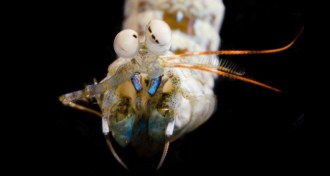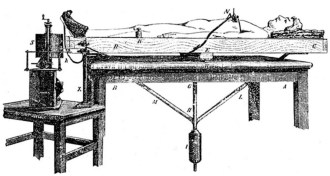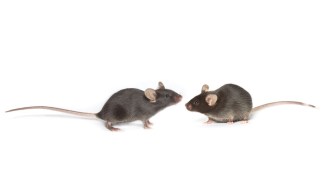Neuroscience
-
 Animals
AnimalsMantis shrimp’s bizarre visual system may save brainpower
The mantis shrimp sees each color separately with one of a dozen kinds of specialized cells, a system that may help the animal quickly see colors without a lot of brainpower.
-
 Neuroscience
NeuroscienceCaffeine’s little memory jolt garners a lot of excitement
A new study claims that caffeine can perk up memory consolidation in students without a caffeine habit. But concerns about the effect size and the statistics in the paper require a little extra shot of replication.
-
 Neuroscience
NeuroscienceThinking hard weighs heavy on the brain
A balance measures the tiny changes in force due to blood flow behind a person's thoughts.
-
 Neuroscience
NeuroscienceCaffeine may improve memory
Taking the stimulant after learning new information boosted people’s recall the next day.
-
 Neuroscience
NeuroscienceA schizophrenia drug turns on protein factories in cells
Haloperidol reshapes neurons, which might explain how the medicine works.
-
 Neuroscience
NeuroscienceHormone hampers effects of marijuana
Study of pot-blocking brain chemical in rodents could lead to new treatments for cannabis addiction.
-
 Neuroscience
NeuroscienceAll mice are the same, until they’re not
A new study shows substantial differences in how two closely related mouse strains respond to drugs. It offers new options for linking genes and behavior and may change how scientists think about the similarity of their mouse strains.
-
 Neuroscience
NeuroscienceYear in Review: Obama unveils brain initiative
In April, the president announced an ambitious plan to reveal the human brain’s secrets.
-
 Neuroscience
NeuroscienceBad memories fade with a short jolt
Research illustrates the vulnerability of the brain’s information storage.
-
 Life
LifeSolving the mystery of Alzheimer’s start
Molecular evildoers team up to launch neural destruction.
-
 Neuroscience
NeuroscienceParkinson’s patients drive better with brain stimulation
Patients make fewer errors with a little help from implanted electrodes, at least on a computer.
-
 Neuroscience
NeuroscienceNarcolepsy may be an autoimmune disease
Narcolepsy occurs when wayward immune forces launch an attack on brain cells responsible for wakefulness, a new study suggests.
By Nathan Seppa